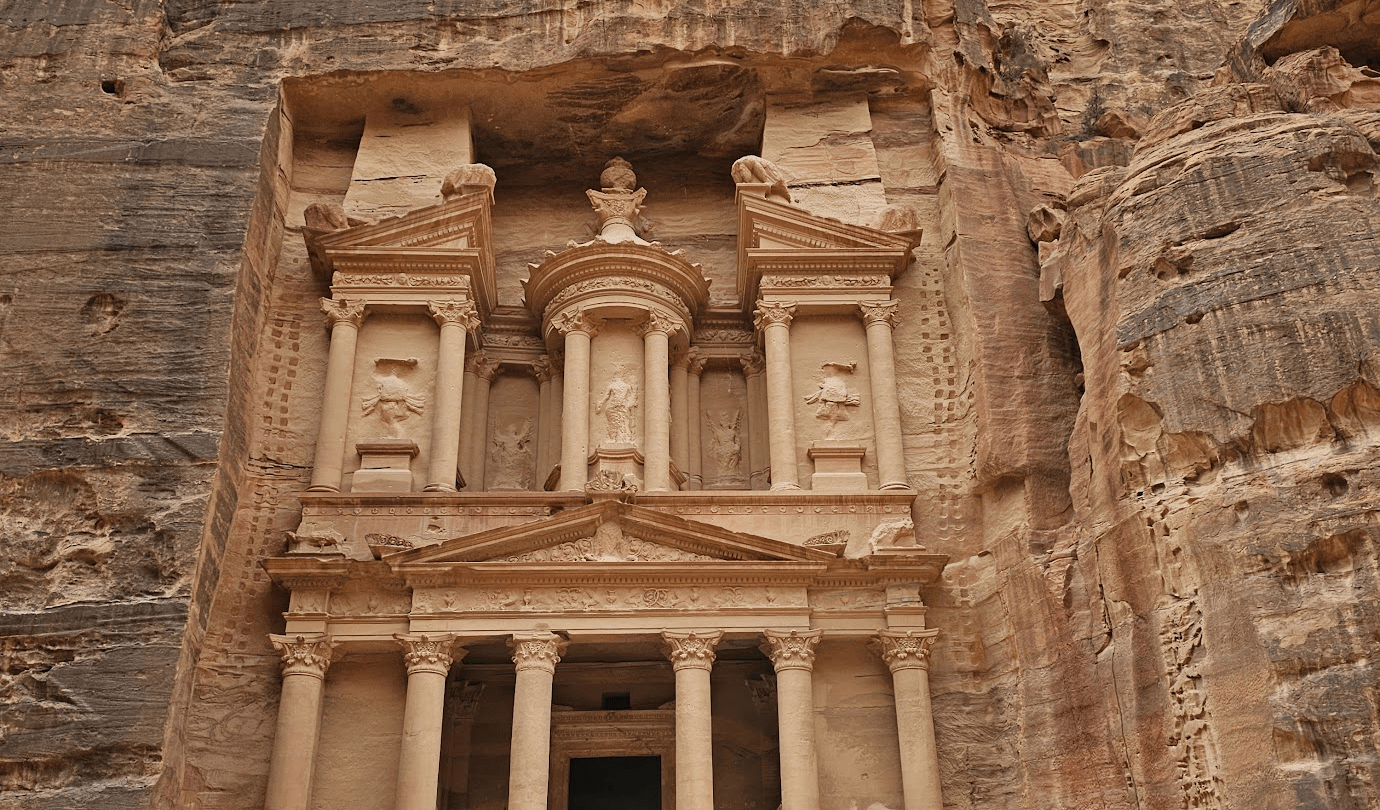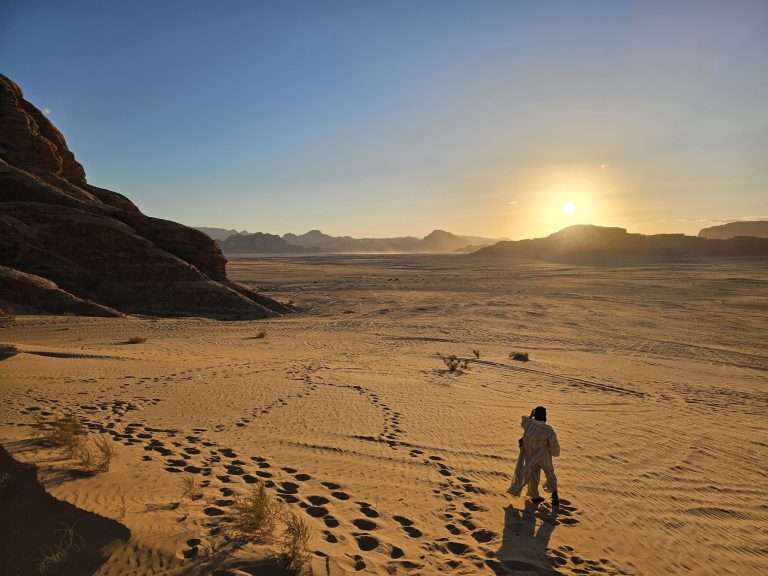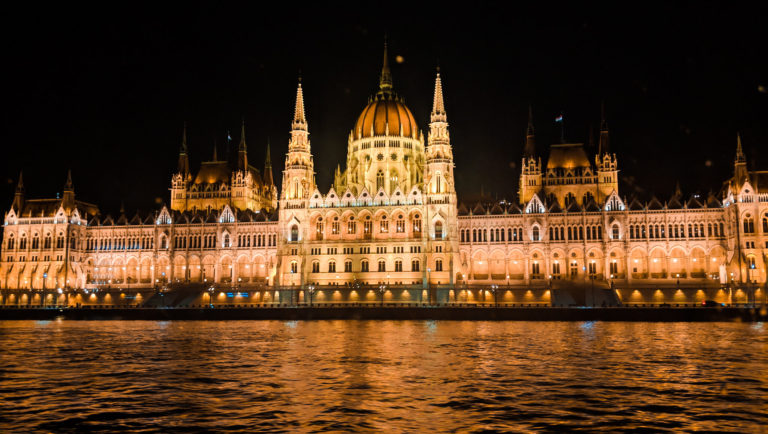Visiting Petra Jordan – All You Need To Know
Are you planning to embark on an epic journey to one of the most incredible archaeological wonders on Earth? Well, hold onto your hats (or hijabs!) because we’re about to dive head first into the captivating world of Petra! In this blog post, I will be covering everything that you need to know when visiting Petra, Jordan.
Get ready for a wild ride filled with jaw-dropping architecture, hidden trails, and a touch of Indiana Jones vibes.
I will be sharing all the insider tips, must-see attractions, and practical advice you need to conquer Petra like a seasoned explorer.
So, whether you’re an intrepid adventurer, a history aficionado, or a curious traveller seeking a transformative experience, this article will help you plan your perfect trip to the UNESCO World Heritage Site of Petra.
Note: This post may contain affiliate links. That means, should you choose to make a purchase through one of the links, I may earn a small commission at no additional cost to you. Thank you for supporting my small business!
Content’s Page
The History Of Petra
- Nabatean Kingdom
- Rediscovery Of The Lost City Of Petra
- Petra Today – Can Tourists Go To Petra?
Everything You Need To Know Before Visiting Petra
- Petra Opening Hours
- Petra Tickets And Entrance Fee
- Jordan Pass
- Best Time To Visit Petra
- What To Wear When Visiting Petra
- What To Bring With You To Petra
- How Many Days Do You Need In Petra
How To Get To Petra
- Where Is Petra Located In Jordan
- Visiting Petra From Amman Jordan
- Visiting Petra From Aqaba Jordan
- Visiting Petra From Israel
Where To Stay When Visiting Petra
- Petra Visitor Center Area
- Wadi Musa (Petra Town)
- Aqaba
Visiting Petra
- Petra Hiking Trails
- Petra Main Trail
- Getting Around Petra
- Petra On Your Own VS A Guide
- Eating At Petra
- Toilets At Petra
- Shopping At Petra
- Is Petra Safe For Solo Female Travellers
Petra By Night
- What Is Petra By Night
- Is Petra By Night Worth It
- Is Petra By Night Safe For Solo Female Travellers
Preserving Petra
- Responsible Tourism And Sustainable Practices At Petra
- The Bedouin Culture
Beyond Petra
- What To Do In Wadi Musa
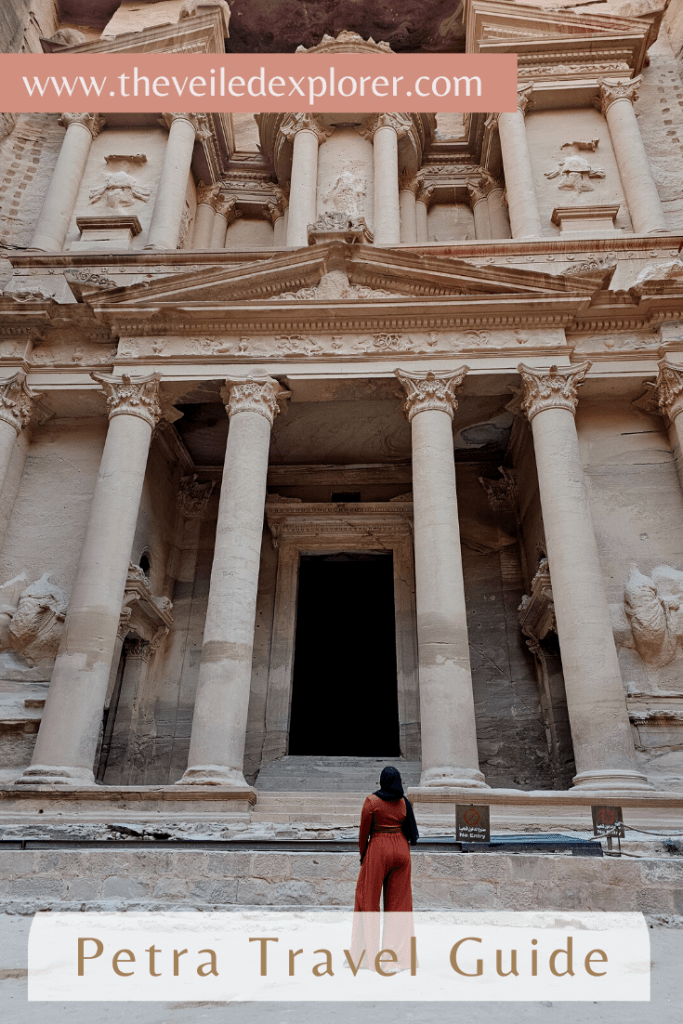
The History Of Petra
Honestly, as important as it is to know how to prepare for your visit to Petra, more importantly, you should know the history of it before visiting. Not only did I NOT get a guide during my visit to Petra, but I didn’t know anything about the history of the Nabateans either.
And trust me, the second you enter the rose city (yes, there’s an entire rose-coloured city behind the Instagram famous Treasury that we know as Petra), you’ll wish you knew more about what you were seeing.
And with that in mind, below you’ll find a brief history of Petra, The Nabatean Kingdom, the rediscovery of Petra and what it’s like today.
Nabatean Kingdom
Over 2000 years ago there existed a kingdom called the Nabatean Kingdom that thrived from 4BC to the 1st Century. Within the kingdom, there resided an ancient Arabian civilization called the Nabateans. They were a nomadic tribe that controlled the trade routes between the Arabian Peninsula, Egypt and the Mediterranean. In particular, the incense route.
Having control of this route meant that the Nabateans controlled the flow of precious commodities such as incense, spices, silk, and other luxury goods, amassing significant wealth and influence.
But what made them truly remarkable was their ability to transform a barren desert landscape into a flourishing civilization. In addition to being highly skilled merchants, the Nabateans were also engineers.

They developed advanced water management techniques, including dam construction, cisterns, and a network of channels to divert and store water. This allowed them to cultivate crops and sustain urban settlements in areas that would otherwise be inhospitable.
Petra served as the capital and economic hub of the Nabatean Kingdom. The city’s impressive architecture, carved directly into the rose-red sandstone cliffs, showcased the artistic and engineering skills of the Nabateans. Elaborate tombs, temples, amphitheatres, and intricate facades adorned with decorative motifs became characteristic features of their unique architectural style.
In 106 CE, the Nabatean Kingdom was annexed by the Roman Empire, marking the end of their independent rule. The Romans incorporated Petra into their province of Arabia, and the city continued to flourish under Roman influence for some time. However, as trade routes shifted and political dynamics changed, Petra eventually fell into decline and was eventually abandoned and forgotten.
You may also be interested in 18 Beautiful South Italian Towns That You Must Visit and 16 Reasons Why Greece Is Muslim Friendly.
Rediscovery Of The Lost City Of Petra

For centuries, Petra lay hidden from the outside world, buried beneath layers of time and forgotten in the annals of history. It wasn’t until the early 19th century that the lost city was rediscovered, thanks to the intrepid explorations of Swiss traveller Johann Ludwig Burckhardt.
In 1812, disguised as an Arab traveller, Burckhardt embarked on a perilous journey through the deserts of Jordan. His aim was to uncover the fabled city of Petra, which had become the stuff of legends among explorers and scholars.
After enduring numerous challenges and overcoming treacherous terrain, Burckhardt successfully made his way to the hidden entrance of Petra.
With a sense of awe and wonder, he beheld the astonishing sight of the Treasury (Al-Khazneh), the jewel of Petra’s architectural wonders. Burckhardt’s rediscovery of this ancient city sparked international interest and set the stage for subsequent archaeological expeditions.
Petra Today – Can Tourists Go To Petra?
In the years that followed, scholars, archaeologists, and adventurers flocked to Petra, unearthing its secrets and shedding light on its magnificent past. These dedicated individuals meticulously excavated the ruins, piecing together the story of the Nabateans and revealing the incredible achievements of this lost civilization.
Today, visitors can walk in the footsteps of explorers past as they venture through the narrow Siq, a winding gorge that leads to the heart of Petra. The anticipation builds with each step, and as the towering cliffs give way, the ancient city emerges in all its glory. The intricate carvings, grand tombs, and majestic temples stand as a testament to the brilliance of the Nabateans.
Petra’s rediscovery has not only brought its ancient splendour to the world’s attention but also sparked ongoing efforts to preserve and protect this archaeological treasure. UNESCO designated Petra as a World Heritage Site in 1985, ensuring its safeguarding for future generations to appreciate and marvel at.
And yes, tourists can go to Petra today! Read on below for everything that you need to know before visiting Petra.
Everything You Need To Know Before Visiting Petra
Petra Opening Hours
To make the most of your visit to Petra, it’s essential to be aware of the opening hours of the archaeological site. The timings can vary depending on the season, but here’s a general guideline:
- Summer (May to September): Petra opens from 6:00 AM to 6:00 PM.
- Winter (October to April): Petra opens from 6:00 AM to 4:00 PM.
Please note that these hours are subject to change, so it’s recommended to double-check the official timings before your visit. Arriving early in the morning allows you to explore the site with fewer crowds and witness the mesmerizing sunrise casting its golden glow over the ancient city.
TIP: When I visited in March, we were allowed to stay inside until 6 pm. I do recommend asking a member of staff at the information centre on the day if you’re allowed to stay longer as well.
Petra Tickets And Entrance Fee
When it comes to entering Petra, there are a few ticket options with different entrance fees. Read on below to find the best option for you.
Jordan Pass
If you are travelling around Jordan and plan on visiting Jerash, Wadi Rum or any other attraction in addition to Petra, then be sure to get a Jordan pass. Not only does it give you access to over 40 attractions in Jordan, but it also includes your visa fees.
How does the Jordan pass work?
- You can apply for your Jordan pass prior to your arrival in Jordan or request one prior to immigration after landing at Queen Alia Airport. If you need a visa to enter Jordan, then please make sure you apply for your pass and have received the digital pass prior to leaving your home airport. You will need to show this as your proof of visa when checking in.
- After arriving at Queen Alia Airport in Jordan, you’ll have to get your passport and Jordan passes activated. There will be an entirely separate section before you get to immigration, so you can’t miss it.
- Now that your pass has been activated, it will be valid for two weeks.
- When you get to an included attraction, you simply need to show your pass and you will be allowed in. Tour guides and additional add-ons are generally not included.
How Much Does The Jordan Pass Cost?
Depending on how many consecutive days you plan on visiting Petra, the price of your Jordan pass will change.
- 1 Day Visit To Petra: 70JD
- 2 Days Visit To Petra: 75JD
- 3 Days Visit To Petra: 80JD
Onsite Petra Entrance Fees
If you plan on buying your tickets during your visit to Petra, then there are different fees depending on your time in Petra.
If you’re staying at least one night in Jordan:
- 1 Day Pass: 50JD
- 2 Days Pass: 55JD
- 3 Days Pass: 60JD
If you cross the border into Jordan to visit Petra as a day trip, you’ll have to pay 90JD at the border. Once you return, you’ll then be refunded 40JD. For more details on this, please refer to here.
If you don’t fall into either one of the above categories, you’ll have to pay an entrance fee of 90JD once you arrive in Petra.
Best Time To Visit Petra

The best time to visit Petra depends on a variety of factors, including the weather, crowds, and personal interests. The climate in Petra can range from sweltering heat in the summer to freezing temperatures in the winter, so it’s important to consider what kind of experience you’re looking for when choosing when to go.
TIP: Personally I found the start of spring to be the best time to visit Petra.
Spring (March to May):
Spring is the best time to visit Petra when temperatures are mild and rainfall is at its lowest. The lush greenery that blooms in this season adds a freshness to the city, making it a perfect time for exploration. However, do note that this season can be relatively busy, so planning in advance is advisable.
Summer (June to August):
Summer can get quite hot in Petra, with temperatures soaring up to 40°C during the day. However, if you don’t mind the heat then this could be an ideal time for travel as there are significantly fewer crowds than other seasons. It’s essential to stay hydrated, wear appropriate sun protection, and plan your visit during the cooler hours of the morning or late afternoon.
Autumn (September to November):
Autumn is another great time to visit Petra as the days are mostly sunny and pleasant. This makes it ideal for long hikes and leisurely strolls around the city. As with spring, it’s recommended to plan ahead to avoid peak crowds.
Winter (December to February):
Winter in Petra can be quite cold, with temperatures dropping below freezing at night. However, if you don’t mind a bit of chill then this could be a great time to visit as there are fewer tourists and you can make the most of your time exploring without any crowds. Just be prepared with suitable clothing and check the opening hours, as they may differ from other seasons.
Regardless of the season, Petra’s timeless charm will undoubtedly leave you in awe of its beauty and historical significance.
What To Wear When Visiting Petra
When visiting Petra it is important to dress properly to have a comfortable visit. Whilst there are some items that you’ll need specifically for winter or summer there are others that you’ll need all year round.
Clothes
If there’s one thing that I’ve learned from living in London, it’s that there’s never bad weather. There are just unprepared people. And what you wear during your visit to Petra makes all the difference.
Whatever the weather always make sure you dress in layers and have a waterproof windbreaker or a waterproof poncho/anorak with you.
I recommend this hooded windbreaker for women and this lightweight waterproof and windproof hooded jacket for men.
Shoes
The most important thing to wear during your visit to Petra is shoes. Whilst I explored in my trainers, I regretted not bringing a good pair of hiking boots.
- If you’re visiting in winter you should opt for a pair of waterproof and lined hiking boots. I recommend these boots for men and this one for women.
- If you’re visiting during the summer and flip-flops are your usual vibe, you should opt for a pair of hiking sandals. I recommend these hiking sandals for men and this one for women.
- If you’re visiting Petra in spring or autumn you should opt for hiking or walking boots.
- Don’t forget to pick up some Merino wool socks to go with your boots.
Winter Warmers
In addition to all the above be sure to pack the following to stay extra toasty during your winter hike around Petra.
- Base Layer: Start with a thermal or moisture-wicking base layer to keep your body insulated and dry. This can be a long-sleeved thermal shirt or a lightweight sweater.
- Mid-Layer: Add a sweater or heated fleece jacket on top of your base layer for additional warmth. Opt for materials like wool or fleece that provide insulation without adding too much bulk.
- Outer Layer: Wear a waterproof and wind-resistant jacket to protect yourself from the elements. Look for a jacket with a hood to shield your head from rain or snow.
- Bottoms: Choose comfortable and warm pants, such as jeans or thermal leggings. You can also consider wearing waterproof pants if there is a chance of rain or snow.
- Footwear: Wear sturdy and waterproof boots or hiking shoes to navigate the rugged terrain of Petra. Make sure they provide good traction to prevent slipping on slippery surfaces.
- Accessories: Don’t forget to wear a warm hat, gloves, and a scarf to protect your head, hands, and neck from the cold. Thermal socks and insulated footwear can keep your feet warm. Sunglasses and sunscreen are also essential to protect yourself from the sun’s glare and UV rays.
What To Bring With You To Petra

Walking Poles
Want some extra support for your hike around Petra? You should opt for a pair of walking poles. I saw a lot of people with this, so you don’t have to worry about looking out of place if you’ve never used a pair. I recommend these lightweight and adjustable trekking poles.
Backpack
Of course, you’ll need the right bag to keep everything in. Whilst I prefer to travel light with my mini Macaroon backpack others preferred to take a standard-sized waterproof daypack. The size of the bag that you choose to take will depend entirely on how much you wish to carry with you.
Personal Comfort
Whatever the climate, the most important thing is to stay hydrated. I recommend this water bottle for your trip to Petra.
And of course, whatever goes in must come out. Whilst there are toilet facilities available at Petra, toilet rolls are not always available. Therefore I recommend always travelling with a pack of these biodegradable flushable toilet wipes.
We can’t talk about comfort without talking about safety. And if there’s one thing everyone should have with them is a Mini First Aid Kit. You never know when a fall might happen or a blister may decide to appear, so always be sure to be prepared. If you’re prone to sprained ankles I recommend this ankle support brace and this pain relief cold gel.
Sun Protection
With very few covered areas in Petra, you are left exposed to the elements. Therefore it is important to protect yourself from the sun. I recommend packing your favourite sunscreen and taking a cap or wide-brim hat with you.
How Many Days Do You Need In Petra
When planning a visit to Petra, the number of days you allocate can greatly impact your overall experience. Below is a breakdown of what you can expect to see and do within 1-3 days in Petra.
One Day in Petra
While a single day in Petra is limited, it is still possible to explore the main highlights and get a glimpse of the ancient city’s splendor. Start by traversing the mesmerizing Siq Canyon to witness the breathtaking Treasury (Al-Khazneh).
From there, follow the main trail to visit significant sites such as the Street of Facades, the Royal Tombs, and the Theater. If time allows, consider trekking to the Monastery (Ad-Deir) for a more adventurous experience.
Keep in mind that with just one day, you’ll have to prioritize and plan your itinerary carefully to make the most of your time. Personally, I only had one day in Petra and I wish I had more.
Two Days in Petra
Allocating two days in Petra allows for a more comprehensive exploration of this archaeological wonder. On the first day, follow the same itinerary as the one-day visit, ensuring ample time to soak in the beauty and details of each site.
On the second day, venture off the beaten path and discover lesser-explored areas, such as the High Place of Sacrifice or the captivating views from the backside of the Monastery.
This extra day provides a chance to delve deeper into the hidden corners and appreciate the grandeur of Petra at a more leisurely pace.
Three Days in Petra
Extending your stay to three days provides an even richer experience, allowing you to immerse yourself in the wonders of Petra and its surroundings. Spend the first two days following the itineraries mentioned earlier, ensuring you explore the main attractions and lesser-known trails.
On the third day, consider taking guided hikes to scenic viewpoints like the Al-Khubtha Trail or the Wadi Farasa Trail, which offer breathtaking vistas and unique perspectives of the ancient city.
Additionally, this extra day allows for more time to appreciate the intricate rock carvings, study the archaeological details, and indulge in the captivating ambiance that Petra offers.
How To Get To Petra
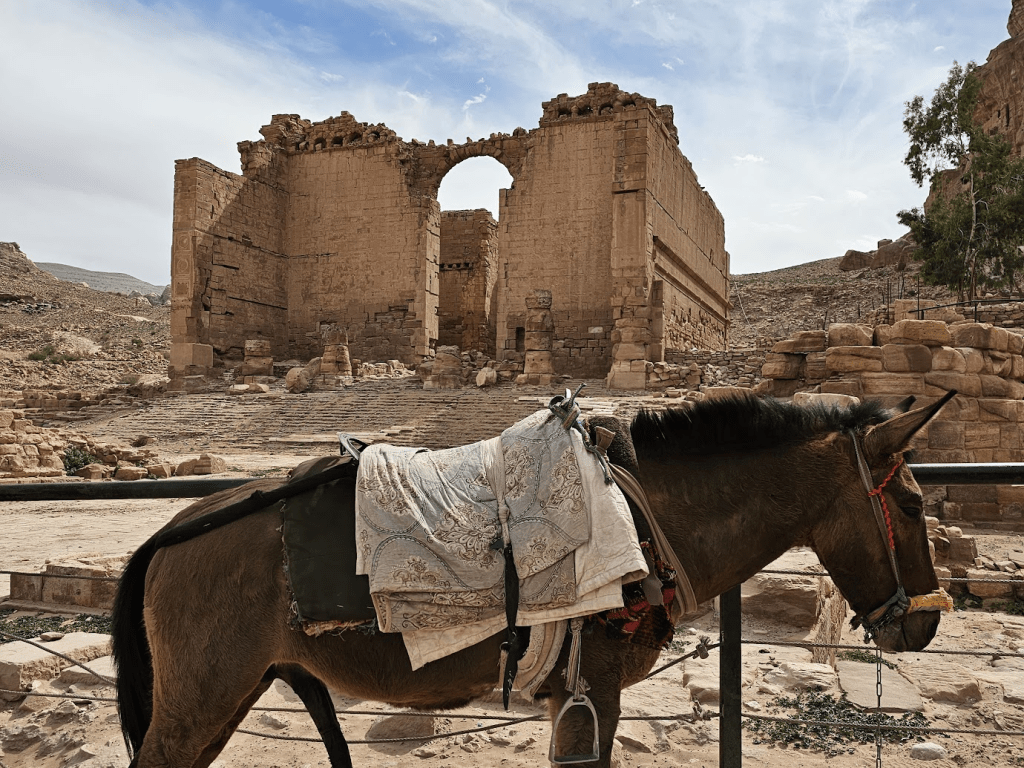
Where Is Petra Located In Jordan
Petra is located in the southwestern part of Jordan. Specifically, it is situated in the Ma’an Governorate, around 240 kilometers (150 miles) south of the capital city, Amman.
Nestled amidst rugged desert terrain and rocky mountains, Petra is tucked away in the eastern side of the Arabah Valley, which runs from the Dead Sea to the Gulf of Aqaba.
Thus making it easily accessible from Either Amman or Aqaba.
Visiting Petra From Amman Jordan
- Private Car: Renting a car or hiring a private driver offers convenience and flexibility. The drive from Amman to Petra is around 3 hours and takes you through scenic landscapes, including the desert and mountainous regions.
- Bus: Public buses operate between Amman and Petra, providing a cost-effective means of transportation. The JETT Bus Company offers daily scheduled services that depart from Amman’s Abdali Station to Petra.
- Guided Tours: Numerous tour operators in Amman organize day trips or multi-day excursions to Petra. These tours often include transportation, guides, and sometimes additional stops at other attractions along the way.
You may also be interested in 18 Best Things To Do In Amman, Jordan or Swimming In The Dead Sea Jordan Guide.
Book Your Tour To Petra From Amman Here:
Visiting Petra From Aqaba Jordan
- Private Car: Renting a car or hiring a private driver is a convenient way to reach Petra from Aqaba. The journey takes around two hours, and it allows you to enjoy the scenic drive through the captivating Jordanian landscapes.
- Taxi: Taxis are widely available in Aqaba and can take you to Petra. Negotiate the fare beforehand or ensure that the driver uses the meter for a fair price.
- Bus: Public buses operate between Aqaba and Petra. JETT Bus Company offers daily services that depart from Aqaba’s JETT Office near Aqaba Castle. The journey typically takes around two hours.
Visiting Petra From Israel
Border Crossing
To reach Petra from Israel, you’ll need to cross the border at one of the designated crossing points. The most common crossing used by tourists is the Arava Border Crossing, also known as the Wadi Araba Border Crossing. It connects the Israeli city of Eilat with Jordan’s Aqaba.
Transportation Options
Once you have crossed the border, several transportation options are available to reach Petra:
- Private Transfer: Arrange a private transfer service in advance to pick you up from the border and drive you directly to Petra. This option offers convenience and comfort, as well as the flexibility to set your own schedule.
- Taxi: Taxis are available at the border crossing, and you can negotiate the fare with the driver. Ensure that you agree upon a price before starting your journey.
- Organized Tours: Many tour operators in Israel offer guided day trips to Petra from locations like Eilat. These tours typically include transportation, border assistance, and a guide who accompanies you throughout the day.
- Rental Car: If you’re comfortable driving in Jordan, you can rent a car in Israel and drive to Petra. However, it’s important to be familiar with the regulations and insurance requirements for crossing the border with a rental car.
Book Your Tour To Petra From Israel Here:
Where To Stay When Visiting Petra
When selecting your accommodation, consider factors such as proximity to Petra, budget, preferred amenities, and personal preferences. It’s advisable to book in advance, especially during peak tourist seasons.
Regardless of where you choose to stay, the remarkable ancient city of Petra will be within reach.
Petra Visitor Center Area
For those seeking the utmost convenience, there are a few hotels and hostels located in the vicinity of the Petra Visitor Center itself.
These accommodations allow you to step out of your hotel and walk directly to the entrance of Petra, saving you travel time and offering the opportunity to enjoy the ancient city at different times of the day.
Petra Moon Luxury Hotel – 5 Stars (6 Minutes from Petra Visitors Center)

Petra Moon Luxury Hotel in Wadi Musa, Jordan, is a 5 stars hotel option known for its luxurious and comfortable stay. Located conveniently near the Petra Visitor Center, the hotel offers elegantly furnished rooms and suites with modern amenities.
Guests can enjoy delicious dining options at the on-site restaurant and benefit from facilities like a 24-hour front desk, free Wi-Fi, and attentive customer service. The hotel’s prime location, warm hospitality, and additional amenities make it an excellent choice for travellers seeking a high-quality experience while exploring the ancient city of Petra.
Petra Boutique Hotel – 4 Stars (5 Minutes from Petra Visitors Center)

Petra Boutique Hotel in Jordan is a charming and intimate hotel located in Wadi Musa near Petra. With stylish and well-appointed rooms, personalized service, and warm hospitality, it offers a comfortable and inviting stay.
Guests can indulge in delicious dining options, enjoy scenic views from the terrace, and experience the authentic charm of Jordanian culture. The hotel’s prime location, attentive staff, and attention to detail create a memorable and authentic experience for travelers visiting the historic city of Petra.
Petra Icon Hotel – 3 Stars (6 Minutes from Petra Visitors Center)

Petra Icon Hotel in Jordan is a well-located and affordable 3 stars hotel option for travellers visiting Petra. Situated in Wadi Musa, it offers comfortable and clean rooms equipped with essential amenities.
The on-site restaurant serves delicious meals, and the friendly staff are always ready to assist guests. While focusing on affordability, the hotel still provides a convenient base for exploring Petra and offers a satisfactory stay with its prime location and essential amenities.
Wadi Musa (Petra Town)
Wadi Musa is the closest town to Petra and offers a wide range of accommodation options for all budgets and preferences. Staying in Wadi Musa provides convenient access to the Petra Visitor Center, allowing you to start your exploration of the ancient city early in the morning.
You’ll find hotels, guest houses, B&Bs and hostels in Wadi Musa, with restaurants and shops close by.
TIP: Personally, this is where I stayed and I loved being close to Wadi Musa Boulevard for my late-night cravings.
Aqaba
If you plan to explore both Petra and the Red Sea coastal city of Aqaba, you can consider staying in Aqaba and taking a day trip to Petra.
Aqaba offers a wide range of accommodations, including beach front resorts, international hotel chains, and budget-friendly options. This allows you to combine your visit to Petra with downtime by the beach.
Book Your Stay Here
Visiting Petra
Petra Hiking Trails
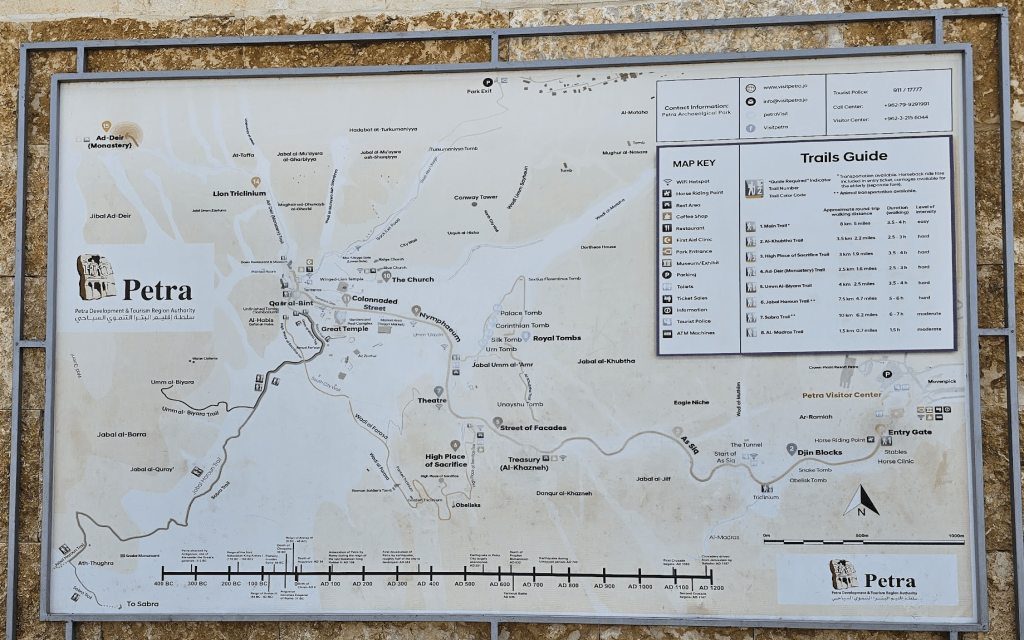
Once you make it to Petra, you’ll have 8 trails to choose from. Below you’ll find the trail name, walking distance, estimated walking duration and the intensity level.
*Guide recommended.
| Petra Trail | Approx. Walking Distance | Walking Duration | Intensity |
|---|---|---|---|
| 1. Main Trail | 8 km / 5 miles | 3.5 – 4 hours | Easy |
| 2. Al-Khubtha Trail* | 3.5 km / 2.2 miles | 2.5 – 3 hours | Hard |
| 3. High Place of Sacrifice Trail* | 3 km / 1.9 miles | 3.5 – 4 hours | Hard |
| 4. Ad-Deir Monastery Trail* | 2.5 km / 1.6 miles | 2.5 – 3 hours | Hard |
| 5. Umm Al-Biyara Trail* | 4 km / 2.5 miles | 3.5 – 4 hours | Hard |
| 6. Jabal Haroun Trail* | 7.5 km / 4.7 miles | 5 – 6 hours | Hard |
| 7. Sabra Trail* | 10 km / 6.2 miles | 6 – 7 hours | Moderate |
| 8. Al-Madras Trail* | 1.5 km / 0.7 miles | 1.5 hours | Moderate |
Petra Main Trail
The main trail at Petra will take you from the visitor center through the ancient kingdom all the way up to the Monastery. Although it’s estimated to take 4 hours, I would suggest 6 hours minimum. This allows plenty of time to photograph Petra, explore the main square and have a lunch rest stop.
Below is what you can see on the main trail at Petra.
1. Petra Visitor Center:
This is where you’ll start off from. If you have any questions about your hike or want to purchase your tickets on the day, this is where you can do it. If you want to purchase any last-minute supplies, you’ll find a range of shops and restaurants by the main gate.
2. As Siq:
The Siq (canyon) is the first site that you’ll come across. It’s an epic, narrow gorge that leads you right into the heart of Petra. Picture yourself walking through towering cliffs, their colours changing with the sunlight. The path twists and turns, adding a sense of mystery and anticipation.
As you make your way, keep an eye out for fascinating rock formations, ancient carvings, and even hidden water channels.
3. Al-Khazneh (Treasury):
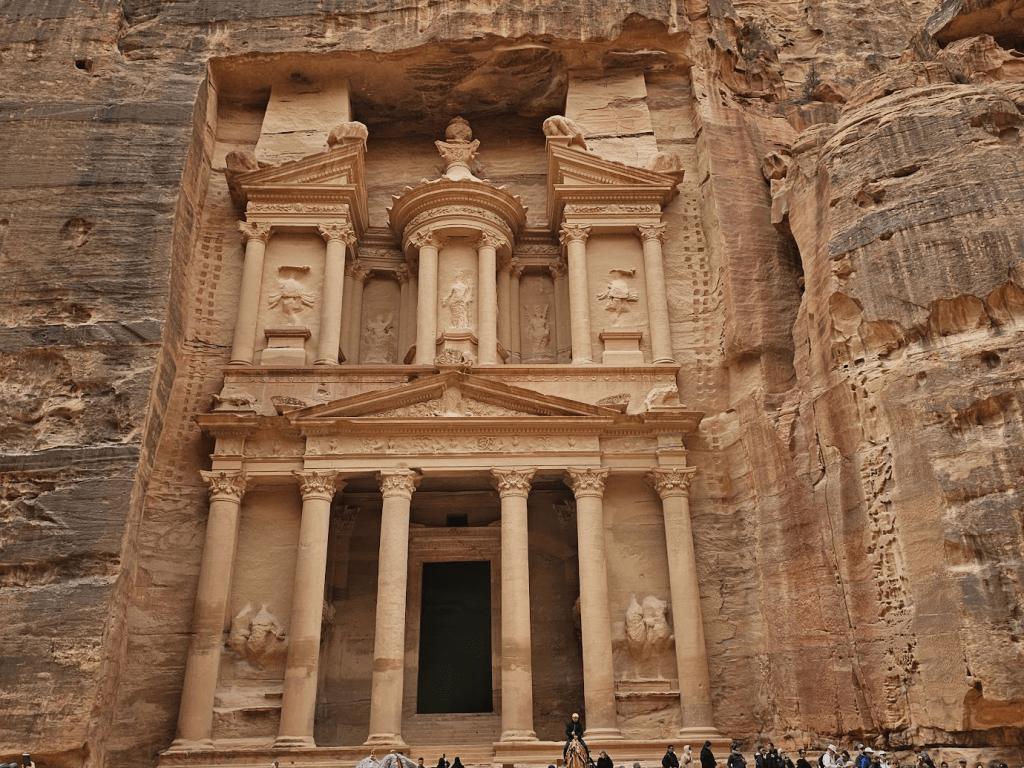
And just when you think it can’t get any better, you catch a glimpse of the Treasury peeking through the narrow opening of the Siq. The Treasury is the main attraction here, so be sure to snap your Instagram-worthy picture before carrying on.
Want a deeper insight? Climb the steps and explore the chambers inside.
4. Street of Facades:
Walking past the Treasury, you’ll enter the Street of Facades, a stretch lined with impressive tomb facades carved into the towering cliffs. These elaborate facades reflect the grandeur and artistry of the ancient Nabatean civilization.
5. Nabatean Theatre:
A short distance from the Street of Facades lies the ancient theatre, an architectural marvel that once hosted dramatic performances and gatherings.
TIP: I recommend photographing The Theatre before noon.
6. The Colonnaded Street:
The Colonnaded Street in Petra offers a glimpse into the bustling past of this ancient city. As you walk along this wide street lined with towering columns, you can envision the vibrant marketplace it once was.
In its heyday, this was the centre of commerce and trade, filled with merchants and vendors offering their goods. Today, you can admire the well-preserved columns and imagine the lively atmosphere of Petra’s heyday.
TIP: Be sure to take in the view from the Great Temple.
7. Ad-Deir (Monastery):
At the end of the Main Trail, you’ll reach the awe-inspiring Monastery (Ad-Deir). This monumental structure, similar in design to the Treasury, showcases the incredible architectural achievements of the Nabateans.
Climb the 1,000 steps to the Monastery’s entrance and soak in the panoramic views of the surrounding landscape.
TIP: The steps are not fatigue friendly! Allow 1–2 hours to go up and down the steps if fatigue is an issue.
Getting Around Petra
Whilst walking is the main way to get around Petra, there are other modes of transport available. Read on below to find the best way to get around Petra for you.
Electric-Shuttle
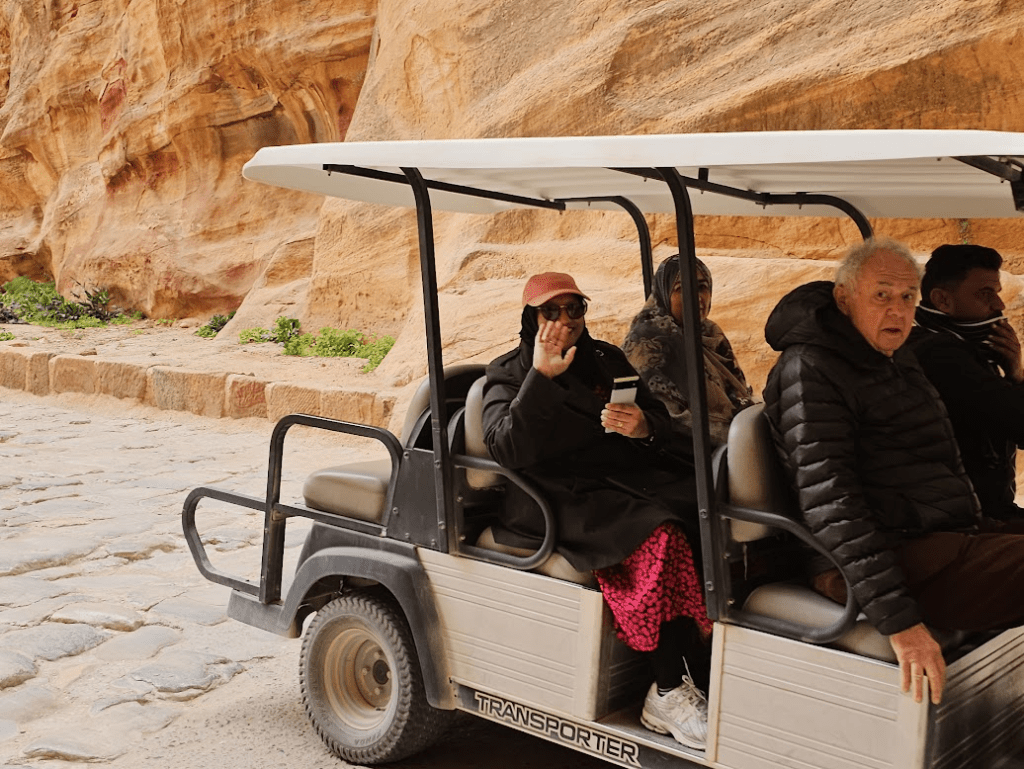
Much to our surprise, there’s an electric shuttle available that will take you from the main entrance, through the Siq, to the Treasury and back. You’ll have the option to purchase your tickets for the shuttle before you enter past the ticketed area.
This is a great option for the elderly or anyone else who would struggle with the walk through the canyon.
Riding Horses, Camels And Donkeys In Petra
In addition to the Electric shuttle, you’ll also have the option of riding a horse, camel or donkey during your visit to Petra. Whilst they are available and a horse ride is included in your entrance ticket, I don’t recommend these options.
The animals are whipped, exposed to the blistering sun all day and truth be told, most people riding the donkeys tend to weigh more than the poor animal. If you can skip it, please do.
Petra On Your Own VS A Guide
If you’re going in just to get a picture in front of Petra to say you’ve been there, you can do it alone. If you’re going in just to hike around and take a gander to say you’ve hiked Petra, you can also do it alone.
But if you want to explore beyond the main trail and/or want to know the history of where you’re standing and the significance behind what you’re seeing, then get a guide. I cannot emphasize enough, that not getting a guide during my visit to Petra is one of my biggest regrets from my trip to Jordan.
Tip: You also consider getting a guide when visiting the Ancient Roman ruins in Jerash, Jordan.
Eating At Petra
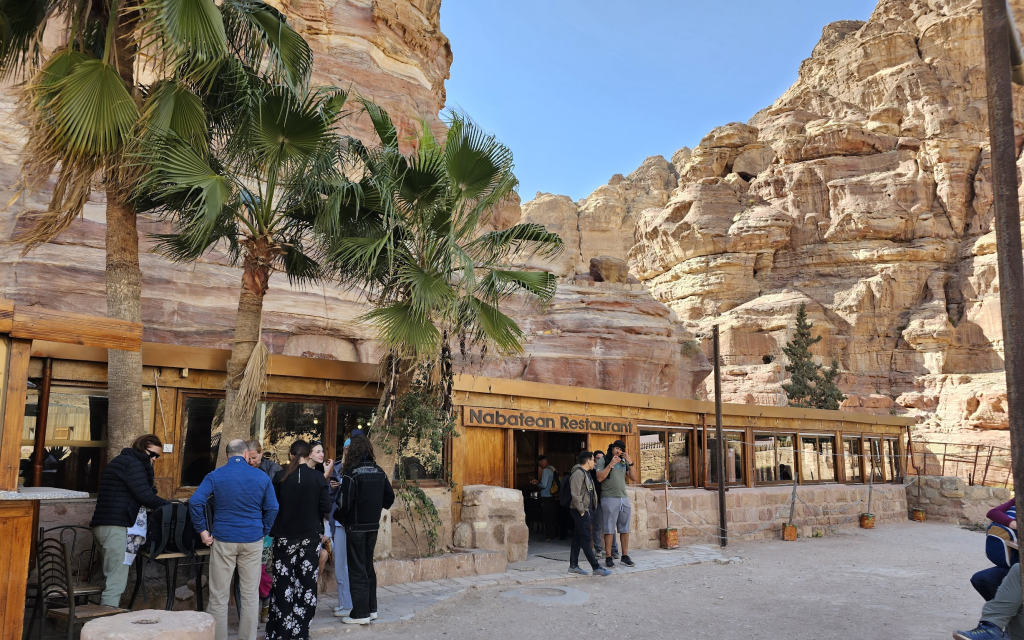
You will not believe this, but my lunch at Petra was hands down one of my favourite meals in Jordan!
You’ll first find food options by the ticketed entrance area. If you fancy a change from kebabs, my mum was able to locate pizzas here. And you’ll then find more restaurants by the Treasury and at the end of The Colonnaded Street.
My recommendation is to eat at the end of the Colonnaded Street, you can’t miss it. It’s a large restaurant called the Nabatean Restaurant with an indoor and outdoor seating area.
TIP: Get the beef kebab, hell, get two! And yes, because you are in Jordan it’s 100% Halal!!
You may also be interested in:
- Best Muslim Countries To Visit In Your Lifetime
- 17 Best Ultimate Halal Holiday Destinations
- The Ultimate Halal Travel Guide
- Top 7 Hijab Friendly Travel Destinations
Toilets At Petra
You’ll find toilets in the main reception area where you purchase your tickets, as well as inside the Nabatean Restaurant. Just remember that toilet rolls may not be available, so remember to bring your own biodegradable flushable toilet wipes.
Shopping At Petra
Just after the Treasury (Al-Khazneh), you’ll find a couple of market stalls reminiscent of what it once must have been like. After shopping around, I can safely say the souvenirs here, well the magnets at least, are cheaper than what you will find outside.
But bear in mind they have been sitting there collecting dust for a while, so the quality may not be the same.
Want something a little more “refined”? You’ll find shops at the entrance of Petra. If you’ve always wanted to own a chequered “Arabian” scarf, you can get one here in addition to other items of clothing and souvenirs.
Is Petra Safe For Solo Female Travellers
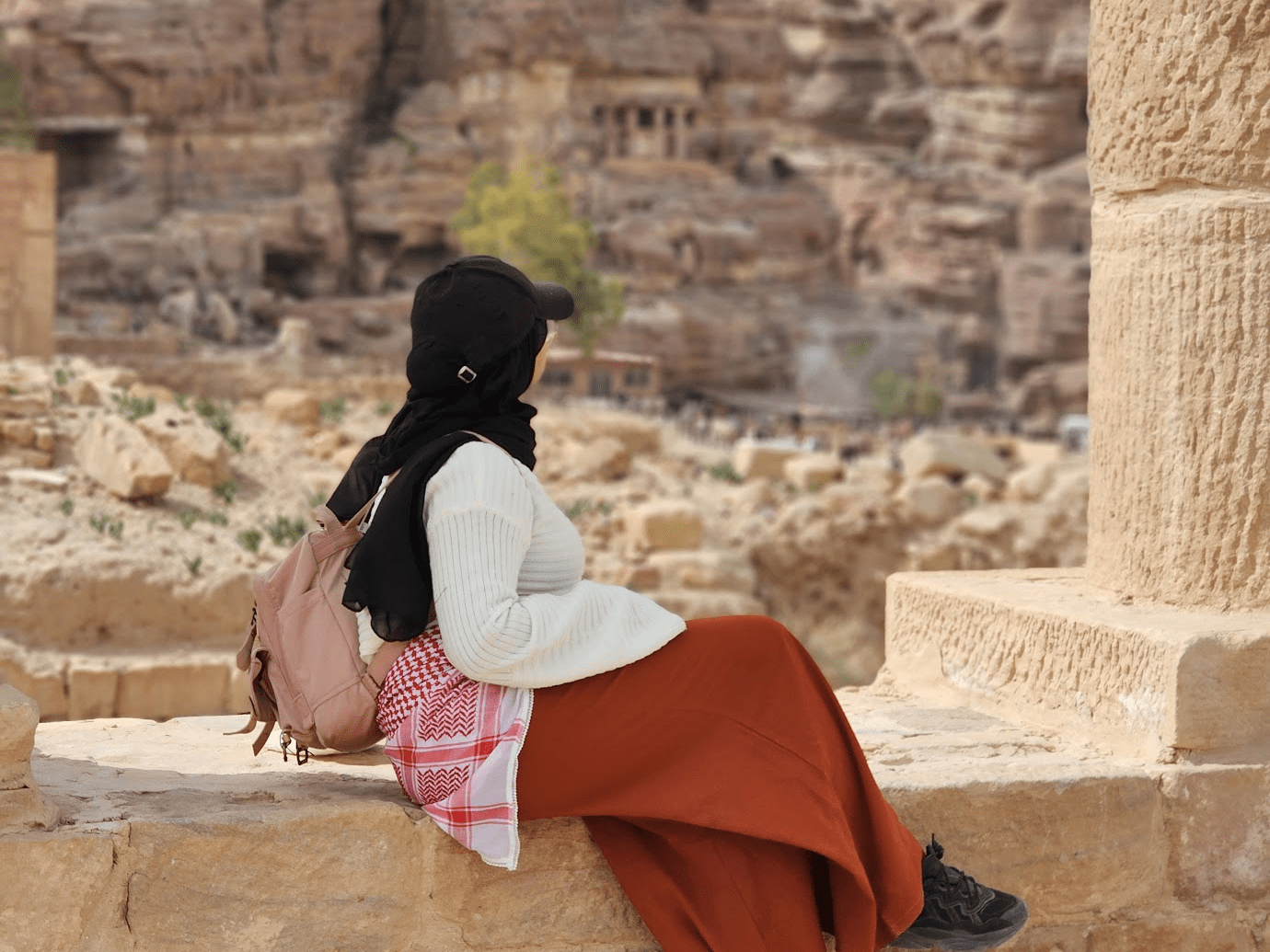
Although I did this trip with family, I would 100% feel comfortable visiting Petra alone as a solo female traveller the next time. Honestly, as long as you stick to the trails and follow the crowds it’s impossible to get lost. And the tourists you’ll find there, beyond the treasury at least, tend to be of a more matured well travelled nature. So (hopefully) the likelihood of being harassed should be low.
You may also be interested in The Ultimate Top 10 Safety Travel Tips and 52 Adventures For Your Best Friend Bucket List.
Solo Female Travel Tips For Visiting Petra:
Nevertheless, here are some tips to keep in mind when visiting Petra as a solo female traveller.
- Plan your visit in advance: Create an itinerary that suits your interests and allows ample time to explore.
- Stay connected: Whilst Wi-Fi is available at the main entrance and restaurants I recommend purchasing a SIM card. This will help you navigate, stay in touch, and access helpful information during your solo adventure around Petra. For convenience, I recommend this eSIM Mobile Data Roaming Plan.
- Inform someone about your plans: Let a trusted person know about your travel plans, including your itinerary, accommodation details, and emergency contact information. Regularly update them on your whereabouts for added safety.
- Be cautious and aware: While Petra is generally safe, it’s essential to remain cautious and aware of your surroundings, especially in crowded areas. Keep an eye on your belongings and be mindful of potential scams or pickpocketing.
- Hire a local guide: Consider hiring a knowledgeable local guide to enhance your experience and gain deeper insights into the history and culture of Petra. They can help navigate the trails, share fascinating stories, and ensure you make the most of your visit.
- Carry essentials: Bring water, snacks, sunscreen, a hat, comfortable walking shoes, and a small backpack to carry your belongings. Be prepared for changing weather conditions, especially during hot summer months or cooler evenings.
- Start early: Begin your day at Petra as early as possible to beat the crowds and have more peaceful moments to explore. This will also give you ample time to photograph popular sites without interference.
- Stay on designated trails: Stick to the designated paths and trails while exploring Petra to ensure your safety and preservation of the archaeological site. Veering off the trails may result in fines or damage to fragile structures.
Petra By Night
What Is Petra By Night

Alright, guys, let’s talk about one of the coolest experiences in Petra – Petra by Night!
Picture this: the moon shining bright, stars twinkling above, and a mystical aura enveloping the ancient city. Petra by Night is like stepping into a fairytale under the Arabian desert sky.
On certain evenings, the Treasury (yep, that mind-blowing carved masterpiece) gets illuminated by thousands of candlelit luminaries. It’s like the most magical sight you can imagine!
As you follow the path through the candlelit dark Siq, anticipation builds with each step. And then, just when you think it couldn’t get any better, you turn a corner, and boom! The Treasury reveals itself in all its illuminated glory. Trust me, it’s jaw-dropping, especially if you’re seeing Petra for the first time.
But wait, there’s more! You’ll be serenaded by traditional Bedouin music as you sit on colourful carpets or folding stools, sipping on warm, aromatic tea. It’s like being transported to another era, soaking in the rich culture and history of Petra. The flickering candlelight, the music, the starry night – it’s pure enchantment.
At least that’s what they promise!
Is Petra By Night Worth It
To be brutally honest, if you’re going purely for the Bedouin show, then NO, Petra by Night is not worth it. However, if you want to see Petra lit up by candlelight and get some night photography in, then Petra is definitely worth it.
If you couldn’t care less about the latter, then I recommend saving your energy for Petra by day.
Is Petra By Night Safe For Solo Female Travellers
Yes, but absolutely make sure you stick with the crowd and leave with the crowd. Do not fall behind once everyone starts to leave, as it gets empty very quickly and can get intimidating alone in the dark walking through the Siq canyon.
And of course it goes without saying to stick to the candlelit path and to not stray. Petra by night is not the time to wander!
Preserving Petra
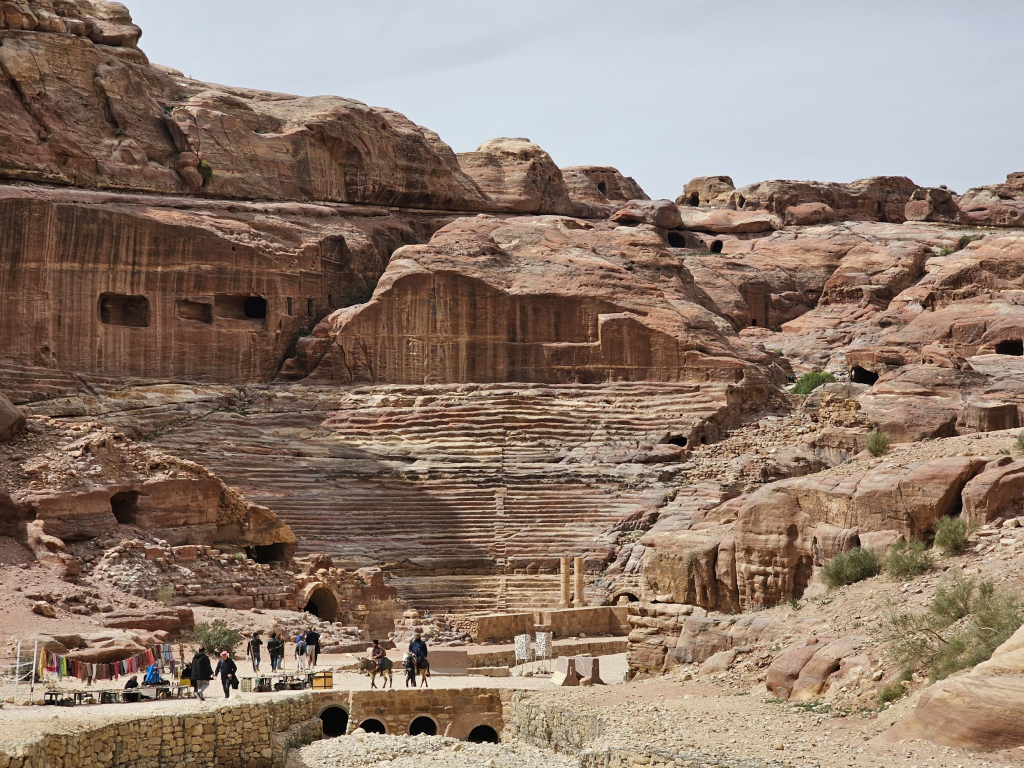
Responsible Tourism And Sustainable Practices At Petra
Let’s talk about responsible tourism and sustainable practices when visiting Petra. We all know that exploring this magnificent ancient city is a dream come true, but it’s important to do so in a way that respects and preserves its cultural and natural heritage.
Here are some tips to be a responsible traveller in Petra:
- Respect the Heritage: Petra is a UNESCO World Heritage Site and a treasure of immense historical value. Show your respect by not touching or climbing on delicate structures. Preserve the integrity of the site by refraining from defacing or removing any artefacts or rocks. Let’s leave Petra as we found it, ensuring its beauty and history endure for future generations.
- Leave No Trace: While exploring Petra, be mindful of your impact on the environment. Carry a reusable water bottle to reduce plastic waste. Dispose of rubbish responsibly in designated bins or take it with you. Remember, the ancient city is a sanctuary for flora and fauna, so avoid disturbing or damaging the natural surroundings.
- Support Local Economy: Make a positive impact by supporting local businesses and artisans. Purchase souvenirs and crafts directly from local vendors, ensuring your money goes directly to the community. Opt for locally owned accommodations and restaurants to contribute to the local economy.
The Bedouin Culture
The Bedouins are the traditional nomadic tribes of the region, and their heritage is deeply intertwined with the history of Petra. Here are some tips to respectfully engage with the Bedouin culture while being responsible tourists:
Learn and Respect Customs:
Take the time to learn about the Bedouin customs, traditions, and way of life. Respect their cultural practices, such as modesty in attire, greetings, and social interactions. Embrace the opportunity to engage with the local Bedouin community, listen to their stories, and gain insights into their rich heritage.
Support Local Bedouin Initiatives:
Contribute to the sustainable development of the Bedouin community by supporting local initiatives. Visit Bedouin-run businesses, such as cafés, handicraft shops, or guided tours, where your spending directly benefits the local people. By doing so, you help preserve their culture and create opportunities for economic empowerment.
Engage in Responsible Camel Rides:
Camel rides are an iconic part of the Bedouin culture and a popular activity in Petra. Ensure that the camels are well-cared for, treated with respect, and not overloaded. Choose reputable operators who prioritize the welfare of their animals. Remember, responsible animal tourism is key to preserving the Bedouin way of life.
Be Mindful of Bedouin Private Spaces:
In Petra, you may come across Bedouin camps or private areas. Always ask for permission before entering these spaces and respect their privacy. Remember, these areas are their homes and should be treated with the utmost consideration.
Share Cultural Exchange:
Embrace opportunities for cultural exchange with the Bedouin community. Engage in conversations, participate in traditional activities like storytelling or tea ceremonies, and learn about their customs first-hand. This fosters mutual respect, understanding, and a deeper appreciation for the Bedouin way of life.
Spread Awareness:
Share your experiences and knowledge about the Bedouin culture with others. Encourage responsible travel practices and promote cultural sensitivity among fellow travellers. By raising awareness, we can collectively ensure the preservation and appreciation of the Bedouin heritage.
Beyond Petra
What To Do In Wadi Musa
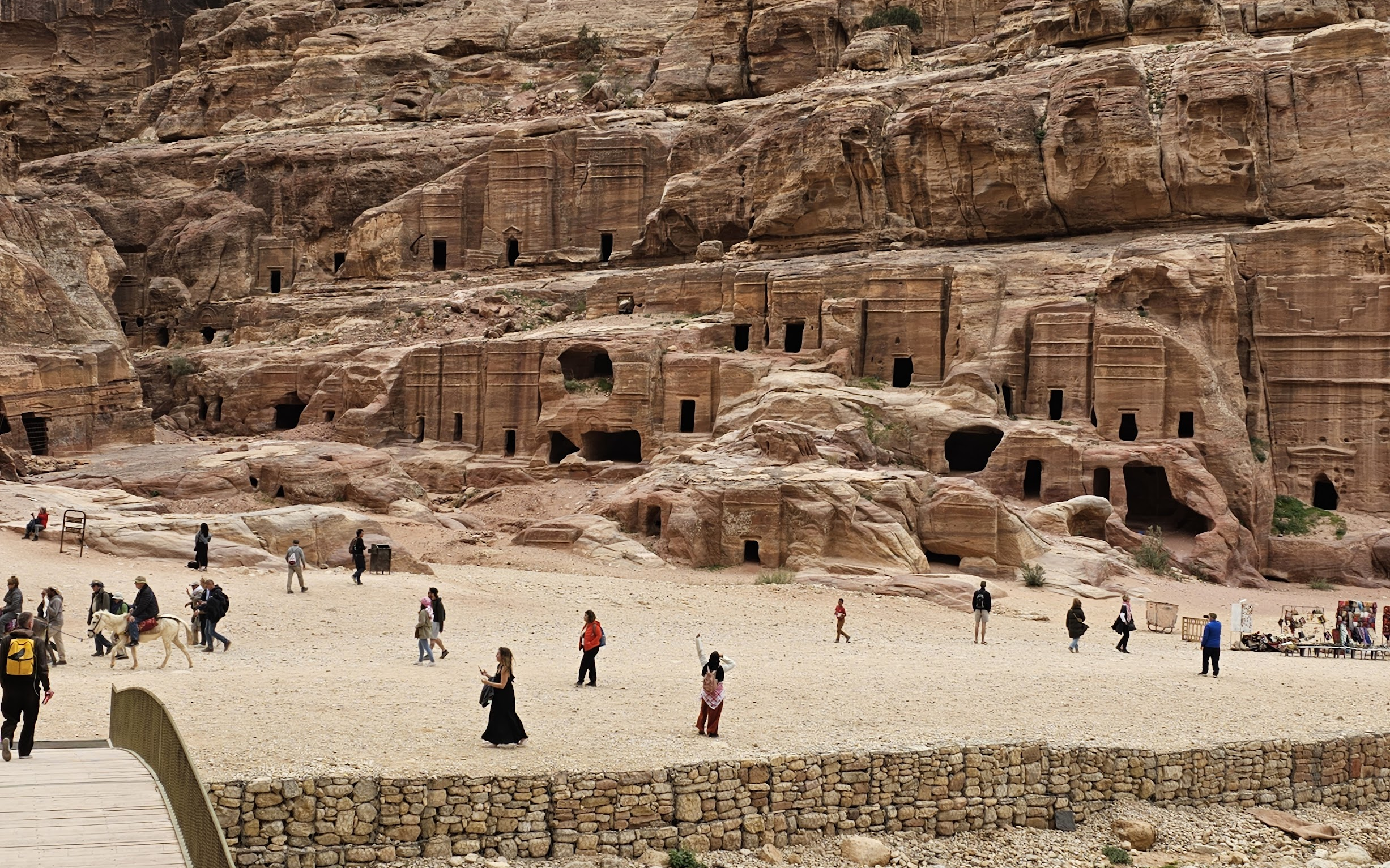
Although Petra is the main attraction in Wadi Musa, here’s what else you can do when you’re visiting Petra.
- Explore the Local Market: Immerse yourself in the vibrant local culture by strolling through the bustling market in Wadi Musa. You’ll find colourful stalls offering traditional handicrafts, spices, textiles, and fresh produce.
- Indulge in Local Cuisine: When it comes to food, Wadi Musa won’t disappoint. Savour traditional Jordanian delicacies at local restaurants and street food stalls. Don’t miss out on the mouthwatering flavours of Mansaf (a traditional lamb dish), Falafel, Hummus, and freshly baked Jordanian bread.
- Discover Little Petra (Siq al-Barid): Just a short drive from Wadi Musa, you’ll find Little Petra – a smaller, more intimate version of its famous counterpart. Take a leisurely walk through its narrow gorge, marvel at the intricately carved facades, and imagine what life was like in this ancient settlement.
- Hike in the Surrounding Nature: If you’re up for some outdoor adventure, Wadi Musa offers fantastic hiking opportunities. Lace up your hiking boots and hit the trails in the surrounding mountains and canyons. The views are simply breathtaking! Don’t miss the Al-Habis trail, which takes you through the captivating Al-Habis Mountain, offering panoramic vistas of the region.
- Visit the Wadi Musa Museum: For history buffs, a visit to the Wadi Musa Museum is a must. It provides a fascinating glimpse into the region’s rich heritage, showcasing artefacts, traditional costumes, and archaeological discoveries. Learn about the ancient civilizations that once thrived in the area and gain a deeper appreciation for the cultural significance of Petra and its surroundings.
- Relax in Turkish Baths: After a long day of exploring, treat yourself to some well-deserved relaxation at a traditional Turkish bath (Hammam).
Conclusion
Well, my fellow adventurers, we’ve reached the end of our Petra journey! I hope this guide has armed you with all the essential information, insider tips, and bucket loads of inspiration to conquer this incredible archaeological wonder.
If you found this useful, be sure to share it with your family, friends and followers on social media. If you have any questions, leave me a comment down below.

